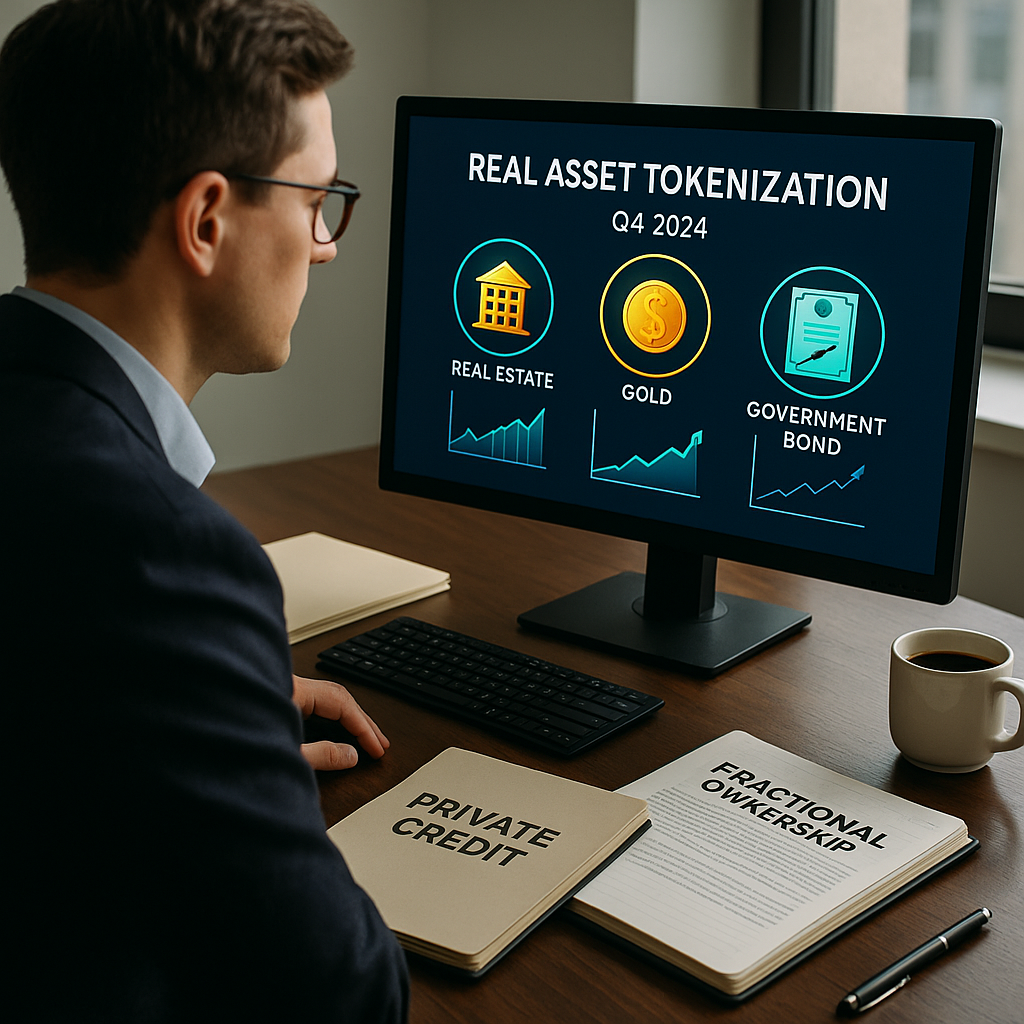Tokenization of Real Assets Gains Momentum
By October 2024, tokenization of real-world assets (RWAs) is no longer a niche experiment — it’s becoming a cornerstone of the next wave of blockchain adoption. From real estate and fine art to government bonds and private credit, institutions and protocols alike are moving toward representing real assets on-chain to unlock efficiency, liquidity, and broader access.
With over $7 billion in tokenized assets now circulating on public and permissioned blockchains, the momentum is undeniable — and strategic players across finance, fintech, and DeFi are building infrastructure for this emerging market.
What Is Asset Tokenization?
Asset tokenization is the process of converting physical or traditional financial assets into digital tokens recorded on a blockchain. These tokens represent ownership or rights to a real asset, enabling:
-
Fractional ownership
-
24/7 trading
-
Programmable compliance and governance
-
Global investor access
Unlike cryptocurrencies, tokenized assets are often backed 1:1 by real-world collateral and issued under regulated frameworks.
Key Drivers of Growth in 2024
1. Institutional Adoption
Banks, asset managers, and custodians are spearheading tokenization efforts. Notable developments:
-
BlackRock launched a tokenized U.S. Treasury fund on Ethereum with over $500 million in AUM
-
JPMorgan Onyx expanded its Tokenized Collateral Network, now used by major banks for real-time repo settlements
-
Franklin Templeton added tokenized MMF shares on both Ethereum and Polygon
These moves demonstrate real utility, not just experimentation.
2. Regulatory Clarity
Countries like Switzerland, Singapore, Brazil, and the UK now offer frameworks for issuing and trading security tokens. The EU’s DLT Pilot Regime entered full effect in 2024, allowing regulated venues to test tokenized assets without full MiFID compliance.
This is giving institutional investors the green light to explore tokenized offerings.
3. Demand for Yield and Liquidity
In a post-ZIRP environment, investors are seeking yield-bearing, liquid alternatives. Tokenized assets allow:
-
24/7 trading of traditionally illiquid instruments
-
Faster settlement cycles (T+0 or near-instant)
-
Access to private markets in smaller denominations
This appeals to both retail users via fintech platforms and institutional allocators through regulated digital custodians.
Real Assets Being Tokenized
| Asset Type | Examples | Use Case |
|---|---|---|
| Real Estate | Commercial buildings, rental units, REITs | Fractional ownership, liquidity |
| Government Bonds | U.S. Treasuries, Eurozone debt | Tokenized fixed income trading |
| Private Credit | SME loans, invoice financing | DeFi integration, risk pricing |
| Art & Collectibles | Fine art, luxury watches | Provenance and fractional access |
| Commodities | Gold, silver, carbon credits | Tokenized ETFs and ESG tracking |
Platforms and Protocols Leading the Charge
Public Blockchain Examples
-
Maple Finance – tokenized lending for crypto-native businesses
-
Centrifuge – bridges off-chain assets (e.g., invoices, real estate) to DeFi
-
Ondo Finance – tokenized treasuries and corporate bonds
-
Boson Protocol – physical goods commerce with on-chain contracts
Permissioned Blockchain Initiatives
-
JPMorgan’s Onyx – interbank tokenized asset settlement
-
Goldman Sachs Digital Asset Platform – private tokenized debt issuance
-
SG Forge (Société Générale) – tokenized green bonds on Ethereum
-
HSBC Orion – tokenized gold and trade finance assets
Both permissioned and permissionless systems are increasingly interoperable, using standards like ERC-3643 and tools like Chainlink’s Proof of Reserve to verify real-world collateral.
Benefits and Strategic Implications
For Investors
-
Access to traditionally exclusive asset classes (e.g., commercial real estate, private debt)
-
Ability to trade fractional shares or units
-
Greater transparency into asset backing and performance
For Asset Issuers
-
Lower administrative costs and operational friction
-
Instant settlement and programmable compliance
-
Expanded investor base across jurisdictions
For Regulators
-
Improved auditability and real-time reporting
-
Enhanced AML/KYC integration via smart contracts
-
Tools to monitor systemic risk across fragmented markets
Challenges and Risks
Despite progress, several challenges remain:
-
Liquidity remains limited outside of U.S. Treasuries and high-profile tokens
-
Custody and asset verification require trust in intermediaries
-
Fragmentation of standards and chains can hinder interoperability
-
Legal enforceability of tokenized claims varies by jurisdiction
To address this, coalitions like the Tokenized Asset Coalition (TAC) and Global Financial Innovation Network (GFIN) are working on unified frameworks and sandbox programs.
Tokenization Meets DeFi: The Next Phase
In 2024, we’re witnessing the merging of tokenized TradFi and DeFi. Examples include:
-
RWAs as collateral in lending protocols like Aave and MakerDAO
-
Programmable bonds that pay interest directly to smart contracts
-
Real-world assets traded in liquidity pools, with real-time pricing from oracles
This convergence is blurring the lines between legacy finance and on-chain ecosystems, enabling composability, efficiency, and financial inclusion.
Future Outlook
Industry forecasts suggest that by 2027, tokenized assets could represent:
-
$10 trillion in total market value, including both public and private assets
-
10–15% of the global bond market
-
$300+ billion in tokenized real estate value
Major financial institutions are now hiring tokenization leads, launching digital asset divisions, and integrating wallet services for institutional clients.
As central banks test wholesale CBDCs, the backbone of tokenized settlement rails is forming — connecting regulated finance, programmable logic, and internet-native infrastructure.
Conclusion: The Real Asset Revolution Is On-Chain
October 2024 marks a turning point for tokenization. No longer theoretical, real-world assets are moving onto blockchains in meaningful, regulated, and investor-friendly ways.
Whether through fractional real estate, on-chain treasuries, or tokenized art, the movement promises not just efficiency — but a more open, liquid, and programmable financial system for the decades ahead.
